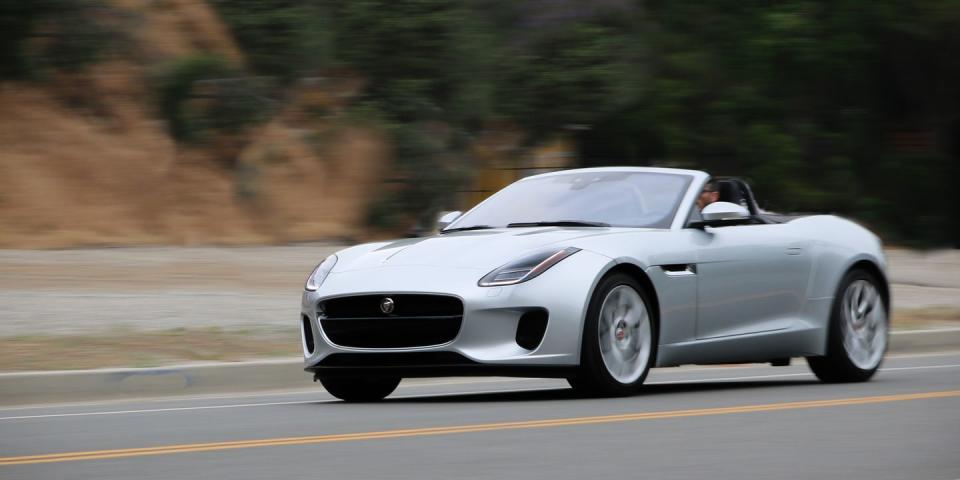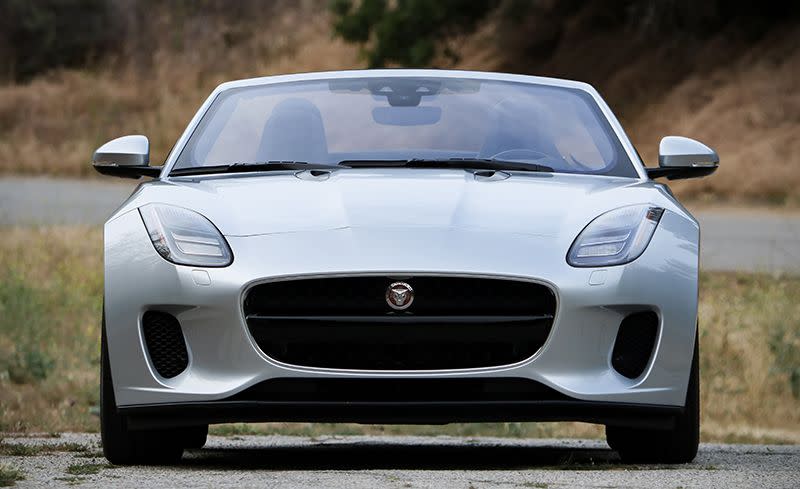The 2018 Jaguar F-type 2.0T Costs Less, Goes Slower

If a sports car's merits were based only on objective performance measures and not subjective attributes such as visual impact, driving experience, or the quality of its furnishings, there's little about the 2018 Jaguar F-type 2.0T convertible tested here that couldn't be matched by a 2019 Mazda Miata that sells for less than half the money.
Alternatively, ignore the F-type 2.0T's performance metrics relative to its pricier V-6 and V-8–powered siblings and note only how similar they all look and feel, and one might wonder why the pricier versions exist. Truth is, performance numbers speak only to certain aspects of the driving and ownership experiences. In the case of the Jaguar's new entry-level F-type coupe and convertible, we noted most of the subjective aspects in reporting on our first drive of the F-type 2.0T models in North Wales last year. Now that we've driven the convertible more extensively in California and have our own test data, we can fully tell its story.
For even deeper coverage, view our Buyer's Guide in-depth review of the 2018 Jaguar F-type.
Meager Acceleration
Frankly, except for generating 0.94 g of lateral grip on our skidpad, this F-type 2.0T didn't deliver impressive performance numbers. Taking 6.4 seconds to get to 60 mph puts it two full seconds behind the last V-6 F-type we tested, an all-wheel-drive 400 Sport coupe, and 0.7 second behind the manual-transmission, 181-hp 2019 Miata we recently tested. This, despite the Jaguar's 296-hp turbocharged 2.0-liter inline-four boasting 115 more ponies and nearly twice the Miata's peak torque output. Weight is the culprit here: At 3647 pounds, the Jaguar is about 50 percent heavier than the feathery Mazda. There's also considerable turbo lag and some non-linearity at high rpm, and the eight-speed automatic transmission has an unfortunate tendency to be caught flat-footed unless it's in Dynamic mode. Simply put, this cat just isn't quick. For the record, Jaguar estimates that the F-type 2.0T can get to 60 mph in 5.4 seconds, but also note that we have yet to match Jaguar Land Rover's acceleration claims in any of its products using this new Ingenium gasoline engine.
Advantages on Paper
The car's window sticker declares potential redemption in the forms of a lower base price and better EPA fuel-economy estimates than its stablemates. Compared with the next rung up on the powertrain ladder-the rear-wheel-drive F-type with its 340-hp supercharged V-6 and similar automatic-the 2.0T costs $9400 less and will go three miles farther on a gallon of fuel, according to the EPA. In Los Angeles traffic, we often found ourselves standing on the go pedal to scurry onto busy streets or merge onto freeways, and using Dynamic mode certainly perked it up-and tickled the ears with a happy snap crackle pop on overrun when lifting off the gas. Drive that way all the time and you won't realize much, if any, fuel-economy advantage over the V-6 models. This, too, is typical of our experiences with Ingenium-equipped JLR vehicles. Take our long-term Range Rover Velar, a car that is driven much more casually with lots of highway miles. So far we're averaging 20 mpg, 1 mpg below its EPA city estimate.
Speaking of engine sound, our car came with the $225 Switchable Active Exhaust system. With the driving-mode selector in its default mode, the engine emits a pleasant growl, but in its Dynamic setting, the note crescendos-with the help of the audio-system speakers-into an artificial rumble, filling the cabin with sounds that resemble the barrel-chested whooomp of an old Audi five-cylinder. It might be cool if it didn't sound so fake. And loud. Thank goodness for the "switchable" part and for it being entirely optional. Save your $225.
Exploit Me
The Jag certainly can turn, however, and it feels lively in corners. Again, this is a factor of weight vis-à-vis its more powerful siblings; not only is it lighter, but most of the weight comes off the nose, leaving it with a 52.2/47.8 front/rear weight distribution that's closer to optimum than the 400 Sport AWD coupe that carries 54.0 percent of its mass on the front axle. Riding on optional wheels with Pirelli P Zero tires measuring 245/40ZR-19 in front and 275/35ZR-19 in back, this F-type generated an impressive 0.94 g on the skidpad. Its overall responsiveness and precision felt particularly outstanding, the lower mass enhancing the sense of immediacy with which the F-type changes direction. It can lean a bit in corners but not objectionably, and while the steering feels light, it's not incongruous with the 2.0T's nimble character. The 165 feet it needed to stop from 70 mph is rather long among comparable sports cars.
As we said when we first drove the four-cylinder F-type, the more modest output poses less risk of overpowering the rear tires and combines with the friskier handling and high grip to make the car's limits feel easier to approach than those of its more powerful siblings. This combination of modest power and high grip is the same formula that makes the Miata the magical creature it is, although the F-type feels more planted deep into triple-digit speeds.
Off-the-Charts Sex Appeal
No Miata, however, conveys the curb appeal of our test car, raised a notch by its 19-inch wheels (a $1020 option) featuring seven Y-shaped spokes and red center caps that match the red Growler grille badge. Like every F-type ever, the 2.0T model is luscious to behold even in a relatively uninteresting Indus Silver color (a $615 option). Once the rolling stock is upgraded, the only giveaway that an F-type is powered by the four-banger is its single, center-mounted rectangular tailpipe set within a smooth black lower diffuser versus the dual round central outlets that come with the V-6 and the quad outboard pipe setup for V-8s. All F-types were refreshed for 2018 with new front and rear bumpers, plus headlamps with thin, horizontal lighting elements that project not just light but more than a little attitude. Like all F-type convertibles, the folding roof is fully insulated and operable at speeds up to 30 mph.
The cabin, too, is nearly indistinguishable from that of the pricier models, with its standard black leather and microsuede upholstery. While the interior design is aging rather more quickly than the exterior, there's little that comes standard on V-6–powered F-types that isn't found here, from a 380-watt Meridian sound system to an electrically adjustable steering column to 12-way power seats and, for 2018, a standard InControl Touch Pro infotainment system with navigation. Decontenting is not part of this car's recipe.
The select options on this example certainly didn't hurt, though, and included an integrated garage-door opener and automatic high-beams for $255 each, proximity entry for $460, and the Climate Package 1 which, for $1380, adds dual-zone automatic climate control and electric heating for the seats, steering wheel, and windshield. Thus equipped, along with auto-dimming door mirrors ($185), blind-spot monitoring with reverse traffic detection ($460), a set of wheel locks ($138), and a car-care kit ($50), the tally came to $69,038. Another $3000 would put you in an F-type convertible with the supercharged V-6 and manual transmission.
Pit it against competitors such as the Chevrolet Corvette, Porsche 718 Boxster, or the just unveiled BMW Z4, and we can't say that the Jaguar F-type 2.0T is our collective favorite two-seat convertible. It's definitely not the quickest. Despite its modest performance, the Jaguar's appeal is considerable, however, deriving from its combination of a genuinely athletic and fully exploitable chassis, uncompromised luxury, and loin-stirring beauty befitting the brand's reputation. The four-cylinder F-type remains strong in overall fun, cabin accoutrements, and sex appeal-qualities that don't necessarily show up on a spec chart but are exactly what makes two-seat droptops so appealing in the first place.
('You Might Also Like',)

 Yahoo Autos
Yahoo Autos 


